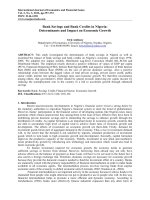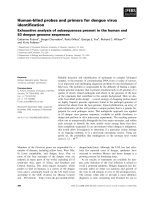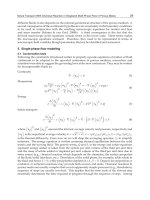Challenging Time in DOPMA - Flexible and Contemporary Military Officer Management doc
Bạn đang xem bản rút gọn của tài liệu. Xem và tải ngay bản đầy đủ của tài liệu tại đây (510.52 KB, 102 trang )
This document and trademark(s) contained herein are protected by law
as indicated in a notice appearing later in this work. This electronic
representation of RAND intellectual property is provided for non-
commercial use only. Permission is required from RAND to reproduce, or
reuse in another form, any of our research documents.
Limited Electronic Distribution Rights
Visit RAND at www.rand.org
Explore RAND National Defense
Research Institute
View document details
For More Information
This PDF document was made available
from www.rand.org as a public service of
the RAND Corporation.
6
Jump down to document
THE ARTS
CHILD POLICY
CIVIL JUSTICE
EDUCATION
ENERGY AND ENVIRONMENT
HEALTH AND HEALTH CARE
INTERNATIONAL AFFAIRS
NATIONAL SECURITY
POPULATION AND AGING
PUBLIC SAFETY
SCIENCE AND TECHNOLOGY
SUBSTANCE ABUSE
TERRORISM AND
HOMELAND SECURITY
TRANSPORTATION AND
INFRASTRUCTURE
WORKFORCE AND WORKPLACE
The RAND Corporation is a nonprofit
research organization providing
objective analysis and effective
solutions that address the challenges
facing the public and private sectors
around the world.
Purchase this document
Browse Books & Publications
Make a charitable contribution
Support RAND
This product is part of the RAND Corporation monograph series.
RAND monographs present major research findings that address the
challenges facing the public and private sectors. All RAND mono-
graphs undergo rigorous peer review to ensure high standards for
research quality and objectivity.
Peter Schirmer, Harry J. ie, Margaret C. Harrell, Michael S. Tseng
Challenging Time
in DOPMA
Flexible and Contemporary
Military Officer Management
Prepared for the Office of the Secretary of Defense
Approved for public release; distribution unlimited
The RAND Corporation is a nonprofit research organization providing
objective analysis and effective solutions that address the challenges
facing the public and private sectors around the world. RAND’s
publications do not necessarily reflect the opinions of its research clients
and sponsors.
R
®
is a registered trademark.
© Copyright 2006 RAND Corporation
All rights reserved. No part of this book may be reproduced in any
form by any electronic or mechanical means (including photocopying,
recording, or information storage and retrieval) without permission in
writing from RAND.
Published 2006 by the RAND Corporation
1776 Main Street, P.O. Box 2138, Santa Monica, CA 90407-2138
1200 South Hayes Street, Arlington, VA 22202-5050
4570 Fifth Avenue, Suite 600, Pittsburgh, PA 15213
RAND URL: />To order RAND documents or to obtain additional information, contact
Distribution Services: Telephone: (310) 451-7002;
Fax: (310) 451-6915; Email:
The research described in this report was prepared for the Office of the
Secretary of Defense (OSD). The research was conducted in the RAND
National Defense Research Institute, a federally funded research and
development center sponsored by the OSD, the Joint Staff, the Unified
Combatant Commands, the Department of the Navy, the Marine Corps,
the defense agencies, and the defense Intelligence Community under
Contract DASW01-01-C-0004.
Library of Congress Cataloging-in-Publication Data
Challenging time in DOPMA : flexible and contemporary military officer management
/ Peter Schirmer [et al.].
p. cm.
Includes bibliographical references.
ISBN-13: 978-0-8330-3948-4 (pbk. : alk. paper)
1. United States—Armed Forces—Officers—Management. 2. United States—
Armed Forces—Personnel management. I. Schirmer, Peter, 1970– .
UB413.C53 2006
355.3'320973—dc22
2006020173
iii
Preface
e U.S. military is far better trained, better educated, more compe-
tent, and more professional than any current or potential rival, which
provides an asymmetric advantage in military operations. To maxi-
mize this advantage, military and civilian leaders in the Department of
Defense (DoD) are examining new policies that would generate higher
returns on investment in military personnel and enhance professional
development. ose policies would enable officers to serve longer in
certain assignments, to have longer careers, and to have more-diverse
career paths. e Defense Officer Personnel Management Act of
1980 (DOPMA) that codified military officer management is based
on fixed career- and promotion-time parameters that make change
challenging.
Recent initiatives reflect the growing recognition that the laws,
policies, and practices governing military personnel management
today will not meet the needs of the future operating environment.
e United States no longer has a cold war enemy but still has a cold
war–era personnel system designed largely to develop and apply mili-
tary personnel to meet a known and relatively unchanging threat.
A shift to a more flexible approach to personnel management
is under way, led by the creation in 2005 of the National Security
Personnel System for DoD civilians. e 2004 National Defense
Authorization Act directed the Secretary of Defense to create a system
that is “flexible” and “contemporary.” at legislation was the culmi-
nation of two decades of demonstration projects that tested alternative
management policies for civilian DoD personnel.
iv Challenging Time in DOPMA
is monograph focuses on changes to law, policy, and prac-
tice that govern promotions for military officers to achieve similar
objectives. Closely related assignment and retirement policies are also
addressed. As such, it should be of interest to decisionmakers, military
personnel managers, and officers themselves.
is research was sponsored by the Office of the Secretary of
Defense and was conducted within the Forces and Resources Policy
Center of the RAND National Defense Research Institute, a feder-
ally funded research and development center sponsored by the Office
of the Secretary of Defense, the Joint Staff, the Unified Combatant
Commands, the Department of the Navy, the Marine Corps, the
defense agencies, and the defense Intelligence Community. e princi-
pal investigators are Harry ie and Margaret Harrell. Comments are
welcome and may be addressed to Harry ie at
or to Margaret Harrell at or to the princi-
pal author at
For more information on RAND’s Forces and Resources Policy
Center, contact the Director, James Hosek. He can be reached by
e-mail at ; by phone at 310-393-0411, exten-
sion 7183; or by mail at the RAND Corporation, 1776 Main Street,
Santa Monica, CA 90407-2138. More information about RAND is
available at www.rand.org.
Contents
vv
Preface iii
Figures
ix
Tables
xi
Summary
xiii
Acknowledgments
xxi
Acronyms and Abbreviations
xxiii
CHAPTER ONE
Introduction 1
A Competency-Based Career-Management System
5
Terms Used in is Monograph
6
Organization of is Monograph
8
CHAPTER TWO
DOPMA and the Time-Based Management System 9
Defining DOPMA
9
Changing Career Paths Within a Time-Based System
13
CHAPTER THREE
Effects of Extending Assignment and Career Tenures 17
Brief Model Description
17
Model Scenarios
19
Longer Assignments (Greater Depth) Result in Fewer Assignments
(Less Breadth)
20
vi
vi Challenging Time in DOPMA
Longer Careers Enable Officers to Have Additional Assignments Only
in the Grade from Which ey Retire
24
Delayed Promotion Timing Allows for Some Additional Assignments
Mid-Career
28
Conclusions About Extending Assignment Lengths
29
CHAPTER FOUR
Outcomes and Characteristics of a Competency-Based Management
System
31
A Competency-Based System Makes Officers Eligible for Promotion
Based on Education and Work Experience
31
Specific Criteria for Promotion Eligibility Vary by Service Community
34
A Competency-Based System Has Broader Promotion Zones
37
Outcomes of a Competency-Based System Might Not Significantly
Differ from ose of a Time-Based System
40
A Competency-Based System Accommodates Additional Mid-Career
Assignments
42
A Competency-Based System Accommodates Longer Time in
Assignments
44
A Compentency-Based System Makes Better Use of Longer Careers
45
A Competency-Based System Allows Services and Service Communities
Greater Control over Outcomes
47
General Characteristics and Outcomes of a Competency-Based System
49
CHAPTER FIVE
Implementing a Competency-Based Career-Management System 51
Changes in Law
51
Changes in DoD Policy
53
Changes in Service Policy and Practice
53
Concerns About Changing the Officer Career-Management System
55
e “Deal”
58
CHAPTER SIX
Conclusions and Recommendations 61
Conclusions
61
Recommendations 63
APPENDIX
Career Path Model 65
Bibliography
73
Contents vii
ix
Figures
2.1. Dimensions and Characteristics of the Defense Officer
Promotion System 12
3.1. Experience Breadth and Depth Trade-Offs with Longer
Assignments 21
3.2. Experience Breadth and Depth Trade-Offs with Longer
Assignments and Longer Careers 24
3.3. Number of O-4 Assignments Plus CGSC for Army Infantry
Officers Promoted to O-5, Baseline Versus Scenario 1
(Longer TIA) and Scenario 2 (Longer TIA, TIS) 26
3.4. Experience Breadth and Depth Trade-Offs with Longer
Assignments, Longer Careers, and Longer Time to
Promotion 29
4.1. Army Infantry Officer Promotion Timing in a Competency-
Based System, Scenario 4 37
4.2. Navy Surface Warfare Officer Promotion Timing in a
Competency-Based System, Scenario 4 38
4.3. Air Force Space and Missile Operations Officer Promotion
Timing in a Competency-Based System, Scenario 4 38
4.4. Marine Ground MOS Officer Promotion Timing in a
Competency-Based System, Scenario 4 39
4.5. Army Infantry Officer Assignments and Education as O-4
and O-5 upon Promotion to O-6 43
4.6. Air Force Space and Missile Operations Officer Promotion
Timing to O-6 with Different Assignment Lengths,
Scenarios 4 and 5 45
4.7. Marine Corps Ground MOS Promotion Timing to O-6
with Different Assignment Lengths and Promotion
Eligibility Criteria 48
xi
Tables
S.1. Comparison of Model Scenarios xv
3.1. Scenarios in RAND Model
19
3.2. Average Number of Assignments in Grade, Baseline Scenario
Versus Scenario 1 (Longer TIA)
22
3.3. Army Infantry O-6s with Various Types of Experience as
O-4 and O-5, Baseline Scenario Versus Scenario 1 (Longer
TIA)
23
3.4. Army Infantry O-6s with Various Types of Experience as
O-4 and O-5, Baseline Scenario Versus Scenario 1 (Longer
TIA) and Scenario 2 (Longer TIA, TIS)
27
4.1. Promotion Eligibility Criteria for Field-Grade Officers in a
Competency-Based System
34
4.2. Army Infantry Outcomes, Baseline Scenario Versus
Scenario 4 (Variable Time to Promotion)
41
4.3. Navy Surface Warfare Outcomes, Baseline Scenario Versus
Scenario 4 (Variable Time to Promotion)
41
4.4. Air Force Space and Missile Operations Outcomes, Baseline
Scenario Versus Scenario 4 (Variable Time to Promotion)
41
4.5. Marine Corps Ground MOS Outcomes, Baseline Scenario
Versus Scenario 4 (Variable Time to Promotion)
42
4.6. Air Force Space and Missile Operations O-6s with Various
Types of Experience as O-4 and O-5, Time-Based Scenario
Versus Competency-Based Scenario
46
xiii
Summary
Background
e RAND National Defense Research Institute (NDRI) has studied
changes to law and policy that would support the Secretary of Defense’s
desire to have officers serve longer in their assignments and in their
careers. NDRI began by studying how assignments and careers could
be lengthened for general and flag officers (grade O-7 and above).
1
A
key finding was that some, but not all, jobs and careers could be length-
ened without significantly affecting promotion opportunity through
the grade of O-9 (lieutenant general or vice admiral). e second phase
of the study, the findings of which are presented in this monograph,
examines how assignments and careers could be lengthened for active-
duty officers in grades O-1 through O-6. e general and flag officer
phase of the study focused on which jobs to lengthen and for which
officers; the current phase of the study focuses on how to enable officers
to have longer assignments and longer careers through changes in law
and policy.
Many of the laws and policies that govern officer career manage-
ment (commonly, if somewhat inaccurately, referred to as DOPMA,
after the Defense Officer Personnel Management Act of 1980) have
been in place for at least the past quarter-century. e Defense Officer
Personnel Management Act was more evolutionary than revolution-
ary. It built upon legislation from the 1940s and 1950s, and some of
1
Margaret C. Harrell, Harry J. ie, Peter Schirmer, and Kevin Brancato, Aligning the
Stars: Improvements to General and Flag Officer Management, Santa Monica, Calif.: RAND
Corporation, MR-1712-OSD, 2004.
its key sections incorporated ideas and policies that had been around
since the 1960s or even earlier (up-or-out, for example, has been a Navy
policy since the beginning of the 20th century, and mandatory retire-
ment at age 62 dates back to the Civil War). DOPMA has served the
needs of the services reasonably well, but there is a growing sense that
the current personnel-management system may not meet the require-
ments of the future operating environment. One of the criticisms of
the DOPMA system is that it does not allow for much variety in the
career paths of most officers. Under the DOPMA system, decisions
about assignments, promotions, and retirements are driven by time-
based laws and policies that are applied more or less uniformly across
the services. As an alternative to the current time-based system, the
emerging focus in defense planning and in the services’ human capital
strategies is on knowledge, skills, and abilities—i.e., officer competen-
cies—as a basis for career management. e focus on managing officer
competencies could require a system with greater flexibility that would
enable certain officers to have longer assignments and longer careers.
Although the expectation by the Office of the Secretary of
Defense is that greater flexibility in career management could improve
organizational outcomes and individual performance, it is beyond the
scope of this research to forecast or predict such effects. We do not
attempt to determine optimal assignment or career lengths, nor do we
recommend specific assignments to be lengthened or identify types of
officers—e.g., specialists, fast-trackers, due-course officers (those whose
careers follow typical time lines)—who should have longer careers. We
focus on changes to law and policy that would enable the desired out-
comes of a future officer career-management system, especially longer
assignments and longer careers.
Modeling Career Path Alternatives
We examined the outcomes of extending assignment and career lengths
in a time-based system and compared them with the outcomes of
extending assignment and career lengths in a competency-based system.
To make that comparison, we modeled the flow of officers through the
xiv Challenging Time in DOPMA
system in a variety of scenarios. We used the current system as a base-
line, and then we examined various scenarios that extend assignments
and careers for specific communities within the military services: sur-
face warfare officers in the Navy, infantry officers in the Army, space
and missile officers in the Air Force, and Marine officers who are not
aviators.
For each of these communities, we produced baseline results using
a set of inputs specific to each community and the laws and policies (or
“business rules”) that govern the officer career-management system. We
refer to these inputs as our Baseline Scenario. We then changed some
of the business rules and compared the new model results with the
results of the Baseline Scenario and with other scenarios, as was appro-
priate. Table S.1 lists the various alternatives. e Baseline Scenario
and Scenarios 1, 2, and 3 use the DOPMA time-based rules; Scenarios
4, 5, and 6 apply a more flexible set of promotion policies that allow for
more-varied time to promotion.
Trade-Offs Between Breadth and Depth in Different
Systems
e DOPMA system is a time-based management system with rela-
tively fixed career “flow points.” e fixed flow points compel a trade-
off between the length and the number of assignments, or between
Table S.1
Comparison of Model Scenarios
Scenario
Baseline 1 2 3 4 5 6
Assignment
length
Status
quo Longer Longer Longer
Status
quo Longer Longer
Career
length
Status
quo
Status
quo Longer Longer
Status
quo
Status
quo Longer
Time to
promotion
Status
quo
Status
quo
Status
quo Longer
More
varied
More
varied
More
varied
Summary xv
xvi Challenging Time in DOPMA
what could be called officers’ depth and breadth of experience. If offi-
cers have longer assignments (greater depth), they will have fewer
assignments within a fixed period of time (less breadth). Lengthening
careers will allow officers to regain some lost breadth by giving them
more time for additional assignments. However, unless promotion
timing also changes, lengthening careers provides additional time only
in the grade from which an officer separates or retires; officers will still
have fewer assignments until they reach their final grade. ese offi-
cers, therefore, may not bring the appropriate breadth of experience to
key assignments throughout their career. Delaying promotion timing
allows officers to have additional assignments mid-career, but, under
DOPMA, it is difficult and cumbersome to delay promotions selec-
tively for some officers but not for others.
A more flexible system would allow for longer careers and would
have wider promotion zones. Conceptually, such a system manages
careers according to competencies rather than according to time.
e key distinctions between a competency-based system and today’s
time-based system are the rules governing eligibility for promotion:
Accumulated experience gained through jobs, education, and training
would make officers eligible for promotion. ere would be no primary
promotion zone, based on seniority, from which most officers would
be selected. e services and service communities would determine
the experiences that would lead to promotion eligibility; presumably,
those criteria would reflect current career guidelines. We would expect
to see “due-course” promotions distributed over multiple years for a
single grade and perhaps even some overlap in the timing of promo-
tions to different grades. While there would be greater variation in
outcomes for individuals, average outcomes would probably resemble
current average outcomes if promotion eligibility criteria reflect current
career guidelines.
A competency-based system can accommodate longer assignments
for some officers, but if a large number of assignments are lengthened,
the amount of time required to accumulate work experience that leads
to promotion eligibility could increase significantly. As a result, either
careers must also be lengthened or the promotion eligibility criteria
must be changed. e latter option is similar to what would happen
with longer assignments in a time-based system: With longer assign-
ments and fixed promotion timing, officers would have fewer assign-
ments in each grade. A competency-based system can also accommo-
date additional assignments or education for some officers who may be
at a disadvantage relative to their peers if they have such assignments
in the current system.
Implementing a Competency-Based Career-Management
System
Making aspects of DOPMA more flexible to allow for officer career
management on the basis of competency rather than time will not
require drastic changes to law or policy. e key phrase in Title 10 of
the U.S. Code that compels a time-based promotion system is “failed
of selection,” which is applied to officers not selected for promotion
while in the primary promotion zone with their peers. Among other
things, the phrase has implications for how promotion zones are con-
structed and how officers are involuntarily separated or retired. Even
without changing Title 10, DoD could provide the services with more
flexibility in managing officer promotions by rewriting its directives
and instructions to omit references to desirable promotion timing and
further clarify that it is acceptable policy for competitive categories
to have different promotion timing and promotion opportunity. is
would be only a partial solution, because it does nothing to address
career lengths and allows only for greater variation across competitive
categories, but not within them.
e greatest amount of work in implementing a competency-
based system will fall to the services and the service communities.
Greater flexibility does not mean greater ease of management; the
opposite is probably true. e biggest challenge will be in identify-
ing the knowledge, skills, and abilities (KSAs) that are conferred and
required by each job, school, and training event. is is not a one-time
effort, particularly on the demand side. Changes in the geopolitical
environment, in technology, and in society have a continual influence
on individual competencies that generate the capabilities of military
Summary xvii
xviii Challenging Time in DOPMA
organizations. Although we modeled a system in which officers are
assumed to develop competencies by virtue of their having had par-
ticular assignments, a complementary or alternative policy would be to
individually assess officers to determine whether the KSAs have been
conferred or developed to the desired level. Assessments could differ-
entiate individuals not only by professional experience but also by the
KSAs actually gained or improved through that experience.
Implementation of a competency-based management system may
not result in significantly different outcomes for many officers, should
the services and service communities believe that current outcomes
yield the right types and mixes of competencies for certain groups
of officers. e extent to which outcomes vary across individuals or
average outcomes shift depends in part on whether assignments and
careers are lengthened and by how much. Variation of outcomes might
also depend on whether individual assessments are used to determine
whether individuals have desired competencies.
Fairness and credibility among the officer corps are the sine qua
non of a new career-management system. Officers must believe that
they are being treated fairly and that the new system produces offi-
cers who are at least as effective and credible as those produced by the
old system. Explicit and implicit contracts—the terms of the “deal”
between officers and the institutions that they serve—may need to
change as more information about the changing environment and
about officer behaviors is known. However, one virtue of the proposed
personnel-management system is its flexibility. Rather than specifying
a single prescription for officer management as most previous systems
have done, we suggest creating boundaries within which managers can
reshape the deal as needed to adjust to changing environments and
changing needs. We would also argue for a gradual implementation of
many of these practices over a period of years, so that the deal can be
viewed as evolving and designed to meet the needs of both officers and
their organizations and institutions. Gradual implementation is also
recommended, because what is known today about required compe-
tencies, particularly for more-senior positions, is often based on subjec-
tive assessments and not necessarily on a more systematic evaluation
of competencies, how frequently those competencies are employed in
an assignment, and the importance of those competencies to job per-
formance. As the system gradually evolves, so, too, should the services’
ability to manage officers’ competencies to meet the diverse operational
needs of the 21st century.
Summary xix
xxi
Acknowledgments
e authors thank the staff of the Deputy Under Secretary of Defense
(Military & Personnel Policy) for their support and assistance, particu-
larly Colonel Francine Blackmon, USAF, Lieutenant Colonel Charles
Armentrout, USAF, and Brad Loo. Many military officers aided us by
providing data and other modeling inputs, reviewing model results,
and providing feedback on the feasibility and desirability of various
policy alternatives. Not all concur with the conclusions and recom-
mendations in this monograph, but all were thoughtful, helpful, and
professional in providing assistance. We particularly want to thank
Rear Admirals Mike LeFever and Scott Van Buskirk, Captain Patrick
O’Rourke, Commander Cheryl Cotton, Lieutenant Commander
Chad Wahlin, and Lieutenant Adam Aycock of the Navy; Colonel
Doug McCallum, Lieutenant Colonels Patrick Fetterman and Dave
Shugart, and Captains Jason Curl and Brian DeSantis of the Army;
Brigadier General Rich Hassan, Colonel Wayne Hudson, and Major
Tim Murtha of the Air Force; and Lieutenant Colonels Michael Kuhn,
John Langford, and Marc Magram, and Majors Craig Kilhenny and
Greg Rouillard of the Marine Corps. Jeffrey Halterman and David
Welch provided assistance as well. Holly Potter deserves special thanks
for her assistance with the career-path modeling.
We also wish to thank our colleagues at RAND who provided
model inputs, shared insights, and reviewed this monograph. ey
include Kevin Brancato, Gary Massey, Major Brian Maue, USAF,
Samantha Merck, Craig Moore, Al Robbert, Michael Schiefer, Georges
xxii Challenging Time in DOPMA
Vernez, and Roland Yardley. We are especially thankful for the excel-
lent reviews of an earlier version of this document provided to us by
Vice Admiral (Ret.) Pat Tracey and by Bill omas of RAND.
xxiii
Acronyms and Abbreviations
Bde brigade
Bn battalion
BTZ below the zone
BZ below-zone (promotions)
CC commander
CGSC Command and General Staff College
CO commander
CONUS continental United States
CTC combat training center
DO director of operations
DoD Department of Defense
DoDI Department of Defense Instruction
DOPMA Defense Officer Personnel Management Act
FMF Fleet Marine Force
G-3 plans officer
GNA Goldwater-Nichols Act
HQ headquarters









